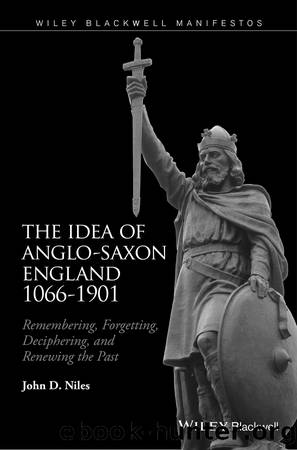The Idea of Anglo-Saxon England 1066-1901 by Niles John D.;

Author:Niles, John D.; [Niles, John D.]
Language: eng
Format: epub
Publisher: John Wiley & Sons, Incorporated
Published: 2015-09-15T00:00:00+00:00
There it is in a nutshell. At last, with these words, the fundamental linking principle of Old English verse had been clearly perceived and stated – by a man whose major contributions to knowledge were in the field of earth sciences.
Nor is this by any means William Conybeare’s only contribution to the study of early English metrics, for in three additional essays written for this part of the volume he discusses the relationship of Old English alliterative verse to alliterative verse composed in Old Icelandic, as well as in several other Old Germanic dialects, to the use of occasional alliteration in Old Irish and early Welsh texts, and to later English alliterative verse from the twelfth to the sixteenth centuries. These are not just metrical treatises, for they introduce English readers to the best current thinking as regards the relationships of these respective languages and literatures while putting on display certain texts of great interest, such as the Old High German Hildebrandslied, highlighting their use of alliteration so as to make their rhythmic structure clear.
Later scholarship has refined the Conybeares’ conception of the ‘metrical laws’ of Old English verse in a number of subtle ways, particularly as regards how to describe the patterned alternations of stressed and unstressed syllables within the confines of the half-line in terms other than ones derived from Greek and Latin poetics. In no way, however, have William’s basic insights, which are based on the closest of collaborations with his brother John,13 been overturned. William deserves credit, as well, for making clear that the eighteenth- and early nineteenth-century custom of printing Old English verse in columns of what we would now call ‘half-lines’ had no substantive justification, for the true unit of Anglo-Saxon versification was the full line linked by alliteration. ‘To me’, he writes, ‘the whole question appears to belong to the typographer rather than the critic’, since the verse itself is unaffected by this issue, though he points out in a footnote that adoption of what has since become the almost universal norm ‘would have the advantage of rendering the alliteration more prominent’ (p. xxxvii).
The great value of the main body of the book – the anthology of ‘Illustrations’ itself – is that it brings into the light of day many Old English texts that had never before been printed (e.g. Deor, The Wife’s Lament, The Phoenix, The Ruin, with translations). Other poems are translated here for the first time into modern English (e.g. The Fight at Finnsburg). The Exeter Book of Old English poetry is the source of most of the items that had not been printed before. John Conybeare made good use of his access to this precious, and previously neglected, manuscript housed in the library of Exeter Cathedral, unhesitatingly recognising its stellar value as a witness to the Anglo-Saxon art of poetry. Worth special note is that William Conybeare provides (at pp. lxxxvii–xcvi) a remarkably accurate prose translation, with critical discussion, of the poem that he calls ‘The Death of Byrhtnoth’ and that today is generally known as The Battle of Maldon.
Download
This site does not store any files on its server. We only index and link to content provided by other sites. Please contact the content providers to delete copyright contents if any and email us, we'll remove relevant links or contents immediately.
Still Me by Jojo Moyes(10789)
On the Yard (New York Review Books Classics) by Braly Malcolm(5393)
Eleanor Oliphant Is Completely Fine by Gail Honeyman(5085)
A Year in the Merde by Stephen Clarke(5078)
The Bookshop by Penelope Fitzgerald(3619)
Surprise Me by Kinsella Sophie(2991)
How Music Works by David Byrne(2964)
Pharaoh by Wilbur Smith(2881)
Why I Write by George Orwell(2775)
A Column of Fire by Ken Follett(2490)
The Beach by Alex Garland(2429)
The Songlines by Bruce Chatwin(2413)
Churchill by Paul Johnson(2364)
Aubrey–Maturin 02 - [1803-04] - Post Captain by Patrick O'Brian(2213)
Heartless by Mary Balogh(2167)
Elizabeth by Philippa Jones(2075)
Hitler by Ian Kershaw(2047)
Harry Potter and the Cursed Child by J. K. Rowling & John Tiffany & Jack Thorne(1972)
The Patrick Melrose Novels by Edward St. Aubyn(1909)
